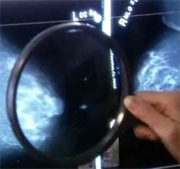
THURSDAY, Jan. 21 (HealthDay News) — Digital mammography delivers significantly less radiation than conventional mammography, and the reduction in radiation exposure may be greater for women with larger and denser breasts, a new study has found.
In the study, researchers analyzed data from 5,102 women who received both digital and standard film mammography.
According to the findings, published in the February issue of the American Journal of Roentgenology, the average breast radiation dose per view was 22 percent lower for digital than film mammography.
“The ability to reduce the radiation dose for many women is another step forward for breast cancer screening with mammography, which saves thousands of lives each year,” study author R. Edward Hendrick said in a news release from the American College of Radiology/American Roentgen Ray Society.
In digital mammography, X-ray images are collected on a digital detector and stored on a computer, rather than being collected and stored on film. A previous study published in 2005 found that digital mammography detected up to 28 percent more cancers than film mammography in women under age 50, in those who were pre- or peri-menopausal, and in women with dense breasts.
“While the radiation dose from both film and digital mammography are low, further dose reduction is an added benefit of digital mammography over and above its ability to better detect cancers in women with dense breasts,” Hendrick added.
Currently, more than 60 percent of U.S. breast imaging facilities offer digital mammography.
“As digital mammography has now been shown to significantly lower the radiation dose, it is likely that access to it will continue to grow,” Hendrick said in the news release.
More information
The U.S. National Women’s Health Information Center has more about mammography.

